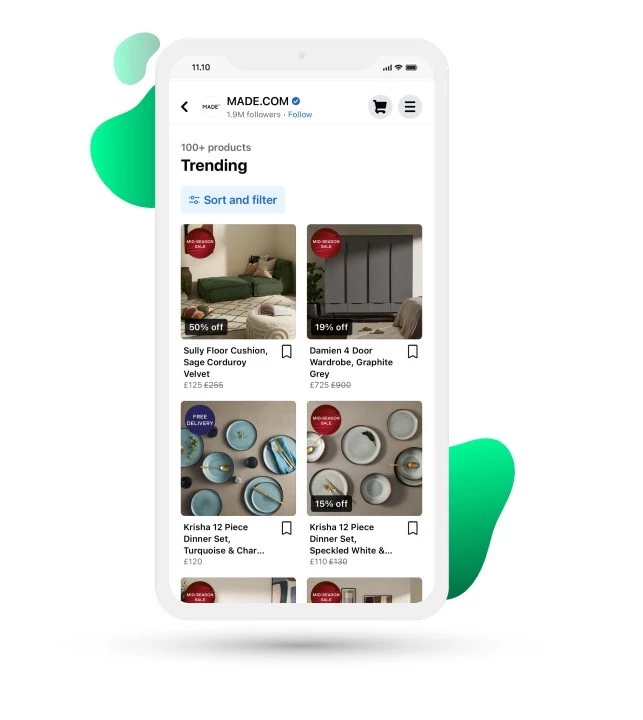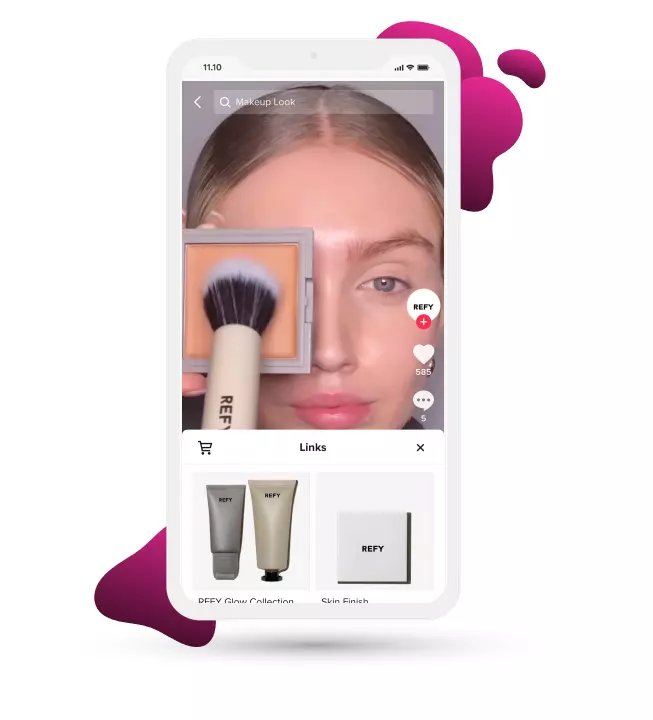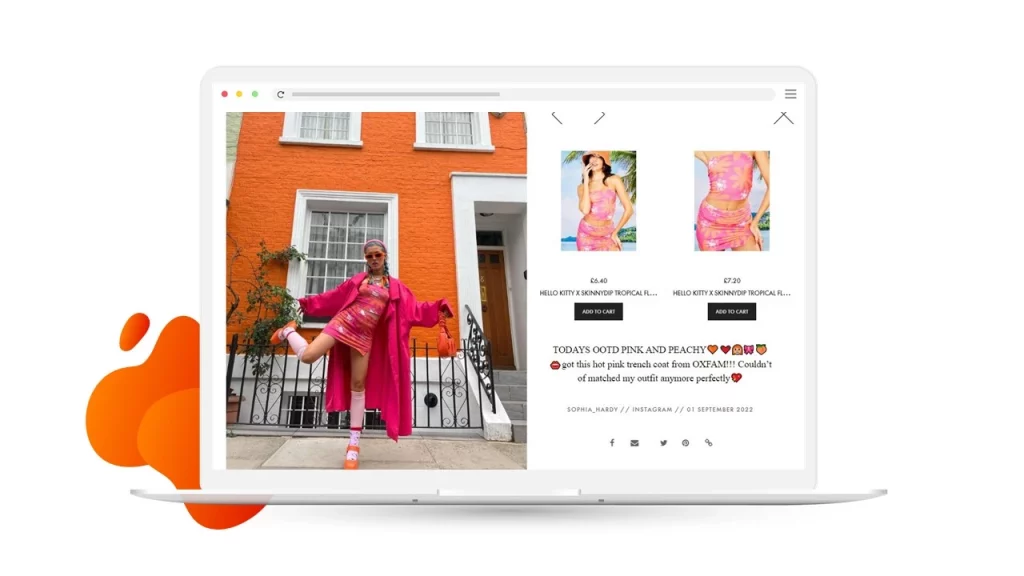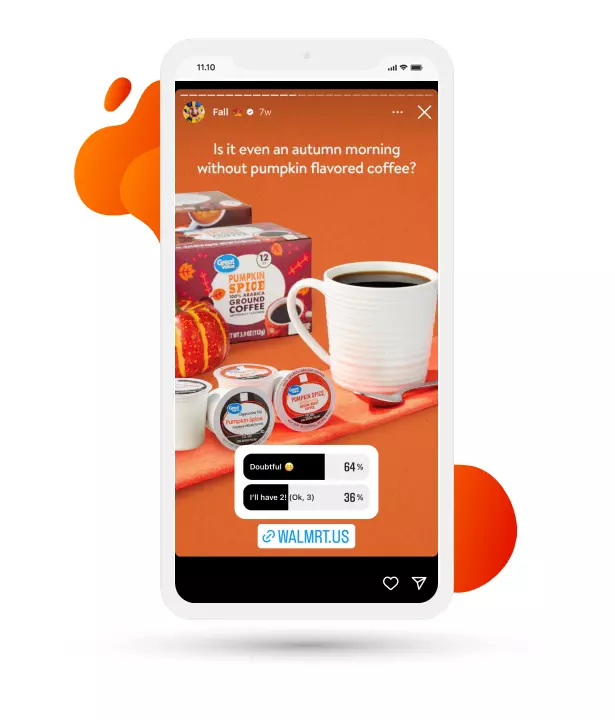What is social commerce?
Social commerce is the innovative online shopping trend that is turning the traditional shopping experience inside out. Social commerce brings the shop to you at the moment you feel an urge to own something, providing a radically simplified purchase path. This form of shopping is also notable because it reduces the chances of distraction on the way to the checkout.
Imagine this scenario: You’re at a party, and your friend is wearing enviable shoes. Social commerce creates an experience that is almost as if you could instantly find out how much the shoes are, and then purchase them yourself, without disrupting the flow of conversation and canapes.
This might sound a bit sci-fi in real life, but online it’s not only possible but profitable. Social commerce provides a shopping experience that is completely integrated into your social media platform of choice from start to finish, so customers don’t have to be taken to an external website.
Social commerce is a form of eCommerce that puts people at the heart of brands’ marketing strategy. And with global social commerce sales expected to reach $1.2 trillion by 2025 according to Accenture, this is one eCommerce trend you can’t afford to miss.
Why is social commerce so effective
Need a trip to the shops? Forgotten what you came out for? Distracted on the way by that great outfit you really can’t afford? More often than not, in-person shopping is a chore that’s expensive, frustrating, and full of dead-ends.
Between online shops and social media, when it comes down to where we’d rather be spending our time, the stats don’t lie. Most of the world’s 4.8 billion internet users are on social media. That’s a lot of potential consumers. And according to Statista, social media users spend on average around 2.5 hours per day on their favorite platforms.
With social commerce, you can smartly integrate your shop seamlessly into the social media browsing experience. This means users can buy a product from the moment they have the impulse to buy it while remaining native on their favorite social media platform. In addition, social commerce has the added bonus of limiting distractions, minimizing the chance of a competitor getting their foot in the door. This all adds up to huge conversion power.
Sold on the benefits of social commerce? Here’s a selection of brands that have mastered this revolutionary new form of online shopping.
Social commerce brands examples
MADE
Eye-catching and aspirational, MADE is a furniture shop that teams up with independent designers to produce quality furniture for homes that appear to have stepped right out of Pinterest. MADE encourages social activity by showcasing the best interiors featuring their products on their owned social media channels and website. MADE leverages its social capital with an attractive Facebook Shop, sharing its best items within the social media app.

Source: Made.com Facebook Shop
REFY
Being co-founded by a successful beauty influencer, this brand knows exactly how to make social work wonders for eCommerce. Their robust TikTok strategy combines exclusive behind the scenes footage, product application videos, “how-tos” and influencer partnership content. REFY is one of the first beauty brands to jump on TikTok’s brand new “TikTok Shops” feature, a trend which will no doubt be the norm by the end of 2022. REFY have made a habit of linking products to the majority of the content in their feed, allowing social media users to buy the products featured, without leaving the platform.

Source: REFY TikTok
Skinnydip London
This young brand started out in 2011 selling personalized phone cases and has since expanded to providing a full range of cool and quirky clothes and accessories infused with bright colors and cartoon collaborations. Skinnydip demonstrates its understanding of the power of customer expression by showcasing its customers’ Instagram posts on its website, and making them shoppable.

Source: skinnydiplondon.com
Walmart
The shopping juggernaut Walmart regularly demonstrates how it keeps on top by embracing new social shopping trends. Walmart’s Instagram page showcases its wide range of items for sale in an attractive and easily sortable way. Walmart make regular use of Instagram’s stories, as a way to engage social media users, tying their shoppable content in with seasons and key events in the calendar year. The team also makes great use of polls, to enable a fun two-way dialogue between the brand and social media users, on their shoppable stories.

Source: Walmart Instagram page
Social commerce platforms
Let’s take a look at the leading social commerce platforms, and what makes them so effective:
Instagram Shopping
Well ahead of the curve, Instagram introduced shoppable tags way back in 2016. These tags serve as mini Calls To Action (CTA) when added to social posts. Through these tags, a browser can instantly find out more information about a product and make a purchase then and there. With one tap, the user is shown the entire range of products from a store. This is a clever way of reeling a user in through one product and encouraging them to widen their interest. And not only this: By adding a shop tab on the home page, Instagram encourages endless product discovery. Ratings and reviews are on the horizon, further cementing authenticity and reliability.
Facebook Shops
Much like Instagram, Facebook Shops provides an accessible and easy way for brands to showcase and sell their products. Facebook allows brands to create a customized digital storefront for free, choose which items they want to feature and tell their brand’s story through the customization of fonts and colors. Products displayed are informed by previous purchases and browser history. And because Facebook owns Instagram, Facebook Shops integrates smoothly across both platforms.
Pinterest Shopping
Pinterest might be considered the natural home of social commerce, as users have regularly used the platform to create mood boards of covetable items, such as wedding lists, or interior decorations and furniture. Whilst having some shoppable content before, the wave of eCommerce brought about by the pandemic inspired Pinterest to create a shopping tab inspired by users’ saved pins. Prices are displayed on each pin, with brand filters and ‘shop similar’ being features that add to the shopping experience.
Snapchat
A social commerce experience close to the sci-fi example given earlier, Snapchat incorporates a ‘scan-to-shop’ function, which allows the user to find shoppable identical or similar items to those they snap in real life. In addition, Snapchat’s try-before-you-buy lens is an augmented reality filter that gives users an idea of what life would look like if they owned a covetable item, and has been used with brands such as BMW.
TikTok Shop
TikTok’s enviable year-on-year growth shows no sign of stopping, and the young social media platform is expected to hit 1.5 billion users by the end of 2022. Trends on Tiktok have shown an ability to cause real-world product shortages, and with many users already discussing products the platform became a prime opportunity for social commerce. TikTok Shop allows users to display and sell products directly through videos, live streams, and also via a shop displayed prominently on their profile page.
How to extend the ROI of social commerce
When it comes to marketing, nothing beats the power of word of mouth and social proof for boosting conversion rates. If you’re in the market for a product, seeing like-minded people sharing their experience of owning that product on social media lends authenticity to a brand, giving you the confidence and assurance you need to get to checkout. This valuable content is known as UGC – user-generated content. UGC can take many forms – images, videos, live demonstrations, and written reviews to name just a few – and is created organically by happy customers.
Social commerce strategies can be taken to a different level by introducing the conversion-boosting power of UGC into the purchase path through smart technology. Now eCommerce marketers can leverage UGC platforms such as Miappi that seek out, aggregate, license, and curate the best UGC to turn this golden content into instantly shoppable social commerce bliss. The result is that brands have access to an always-on source of evergreen content, ready to fuel any social commerce strategy. And having more of this authentic content showcasing products means more shoppable content to drive sales through the roof.
Here’s how to supercharge your social commerce strategy:
1. Regram and social ads
Social media is a content-hungry beast. Thankfully, UGC comes to the rescue. Reposting rights-approved UGC is a fast way to generate huge amounts of content. And not only that, UGC really comes into its own when compared to its brand-created equivalents.
The team at Miappi have found that when clients republish rights-approved UGC via their social networking profiles, they can achieve up to 7x the engagement compared to brand-created content. Make that shoppable and you’re in conversion heaven, as the path to purchase is dramatically shortened, and made frictionless.
2. UGC on product pages
It’s easy to make the transition between social and shopping seamless by displaying images and video UGC from social media, on a variety of pages on your online store through UGC platforms such as Miappi. You’ll be benefitting from the impressive influence UGC created by happy customers can have on purchase decisions. Inject UGC onto your home pages, product detail pages, cart pages and much more to give your customers confidence through social proof.
3. UGC and personalization
It’s well known that eCommerce ROI can be maximized by showing the right products at the right time. Through Fresh Relevance’s collaboration with Miappi, brands can personalize the cross-channel experience based on real-time customer data, as well as contextual data. By matching this data to relevant UGC based on products they’ve previously bought or browsed, Fresh Relevance x Miappi increases the chance of new and repeat business.
The future of social commerce
Fresh Relevance and Miappi help eCommerce businesses combine the power of shoppable social content with sophisticated cross-channel personalization, elevating the shopper experience and boosting sales and AOV.
Book a demo today to learn how personalization with shoppable UGC can improve your eCommerce KPIs.






